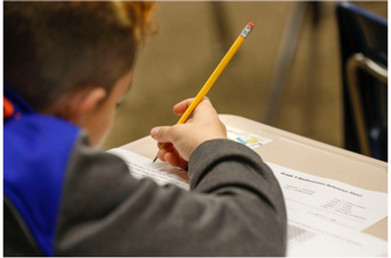“Teaching to the Test” Is the Real March Madness
- andreasachs1
- Feb 15, 2022
- 3 min read
By Carly Mitchell / New York City
(The author, a public-school teacher, is using a pseudonym for professional reasons)
My apologies, T.S. Eliot, but I have to disagree. April is not the cruelest month. These days, it’s March.
Last March, while I was teaching high school virtually, I felt optimistic. Remote learning was a nightmare, but it seemed like a new dawn was approaching. Vaccines were becoming widely available, mandatory state tests for students were canceled, and I was certain that the New Normal was going to mean more positive changes in the New York City school system. Perhaps a future in which (dare I even put this thought into the universe?) there were no more state tests at all.
Alas, the New Normal is an unfortunate step back to the Old Normal. This March, the loathsome ELA state tests (English Language Arts) return to the stage. This is not an exciting performance. Rather, the students and the teachers at the middle school in Brooklyn where I currently teach would prefer to sit in the audience and throw tomatoes.
As I wrote last week in “Why Can’t Pandemic Johnny Read," my seventh graders are reading on average at a fourth grade level. Some even read at a first-grade level. It should come as no surprise to readers that the achievement gap between poor, urban Title 1 schools (like mine) and wealthier, better-resourced non-Title 1 schools is a very real thing. Pair that with the pandemic and you have yourself a literacy travesty.
So why must the ELA state test show go on? I’ll tell you why. Because of data. The most important educational buzzword of the past few years. And while yes, data is important, at some point we need to consider the reality of our current situation and perhaps reevaluate whether state tests are really the most accurate way of collecting that data. I take issue with testing as a performance indicator for schools in general, but I especially take issue with it in the midst of a global pandemic.
I am going to be as candid as possible here. The ELA state test is incredibly boring. It is comprised of a series of questions--multiple choice, short response, and essay–based on excerpts from literary and informational texts. The excerpts are usually uninteresting (although every once in a while, you may find a diamond in the rough) and the multiple-choice questions are often tricky and meant to confuse students. I feel that the practice of “teaching to the test” deters young people from appreciating literature. If we have to administer state tests, can’t we at least make the passages somewhat interesting? Is that too much to ask?
Alas, it is crunch time. In order to ensure that our students are as prepared as possible, teachers are hosting morning preparation sessions from 7:15- 8:00 a.m, (school begins at 8:10 a.m.) and afternoon sessions on Wednesdays and Thursdays from 2:30-4 p.m, (the end of the school day). We are of course paid for these “zero periods” as they are called. I will be teaching as many of these sessions as I can , because I, as every teacher does, need the extra money, and hope that my students attend. Our classroom curriculum will also be transformed. Three periods a week are now designated official test prep periods.
But I am already anticipating challenges. For example, how do I teach seventh-grade test material when there are so many students who are below grade level? How do I help these students feel encouraged rather than discouraged? How can I ramp up engagement in order to prepare students who have not sat through a very long and tedious three-day test since they were in the fourth grade?
I suppose I will have to navigate these challenges as they arise and anticipate. Until then, I will eagerly await April.

Carly Mitchell (a pseudonym) is a public-school teacher in Brooklyn N.Y. who loves to learn, to educate, and to expose the hypocrisy of New York City politicians.


















Comments